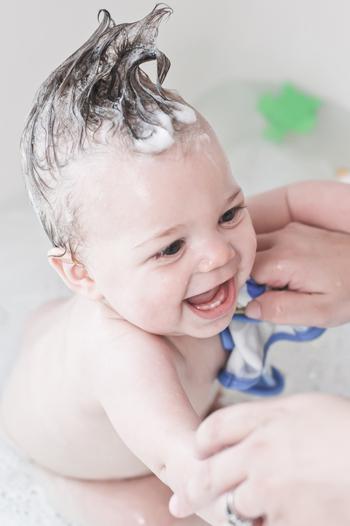Splish splash - I'm having a bath
Duration/age

Splish splash, I’m in the bath and having lots of fun.
Let your child play, exploring the water and how it moves as they swish their hands and legs. Let them try and scoop up the water with their hands, exploring what happens when they open their fingers. Does the water stay put or does it trickle out slowly and run back into the bath?
Soak a cloth or flannel in the water and watch how it changes from being dry and stiff to wet and squishy. Gently put the flannel on different parts of your child’s body. Talk to your child about what happens with the flannel when you put it on top of their head. Does the water stay in the flannel or does it dribble out and run down their nose and chin?
As you wash your child, name the different parts of their body. Ask them to help you name each one. Maybe they can help and tell you what to wash next.
These are your fingers. Are they clean enough yet? What should we wash next? Your thumbs?
Talk about what you are using to wash with. Work together to try and figure out what else you could use for washing different parts of your body, such as shampoo for your hair.
Materials you will need
- Bath
- Soap
- Towel
- Wash cloth or flannel
Skills this activity improves
Why does this matter?
Having a bath is an opportunity to learn and use the names of the different parts of your body. Once children know the names of their body parts, they begin to combine with other information, such as direction, position or action.
When you ask your child questions they are practising listening and responding to a question and they are developing thinking and problem-solving skills.
What does this lead to?
Developing language skills that includes listening and responding helps children to develop new words and language and to hear how sentences or questions are put together.
By listening then responding, your child hears how you talk and has the opportunity to try and respond using similar words and sentence structures. It is by practising with an adult - and hearing different styles of language - that children develop a rich expanded vocabulary. As a child’s language expands, the number of words they use in a sentence will also expand.
Language to use
- Bath, towel, soap, wash cloth, flannel
- Arm, leg, foot, fingers, toes, head, shoulder, elbow, nose, chin, hair
- Trickle, splash, run, scoop, seep, ooze, pour, dribble, drip
- Top, down
- In, under, through
Questions to use
- Where is the flannel?
- Where did the water go?
- Will the water stay in your hands?
Useful tips
- You might also like to take a look at the activities It's bath time and Routines
- For safety information visit www.parenting.sa.gov.au
- The blue book has useful information about language development.
- Remember to talk to your child in your home language.
More ideas
- Play Simon Says.
- Ask your child to try and name different parts of their body as they dry themselves off after the bath.
- Borrow books from your local library about your body and dressing.
- Set up a baby bath and let your child wash their dolls.
- If you have a baby let your child help you to wash the baby.
Variation by age
Birth to two year olds
- Use paper plates to make collage faces.
- Use a mirror to look at the different parts of your child’s face. What faces can you pull in the mirror?
- Sing songs about the body such as heads and shoulders or “do your ears hang low?”
- Set up a doll’s house
Three to five year olds
- Cook gingerbread men
- Make face biscuits.
- Make collage people, creating different body parts and clothing for the people.
- Set up a doll’s house.
- Draw each person in your family. Write the names of the body parts next to the pictures.
Questions to ask
- Where is your nose?
- What do you smile with?
- How many eyes do you have?
- Who has a nose?
- What do you use your fingers for?
Questions to ask
- Where do the eyes go?
- How many eyes do you have?
- What is on the top of your head?
- What is inside your mouth?
- Do we have the same number of teeth?
- What if we didn’t have ears?
- How do you know what a lolly tastes like?
- How many fingers do you have?
Language to use
- Head, shoulder, neck, eye, nose, mouth, teeth, tongue, cheeks, eyebrows, eyelashes
- Happy, sad, cross, angry
Language to use
- Head, shoulder, neck, eye, nose, mouth, teeth, tongue, cheeks, eyebrows, eye lashes
- Happy, sad, cross, angry
- Arm, leg, fingers, palm, knee, shin, foot, toe


